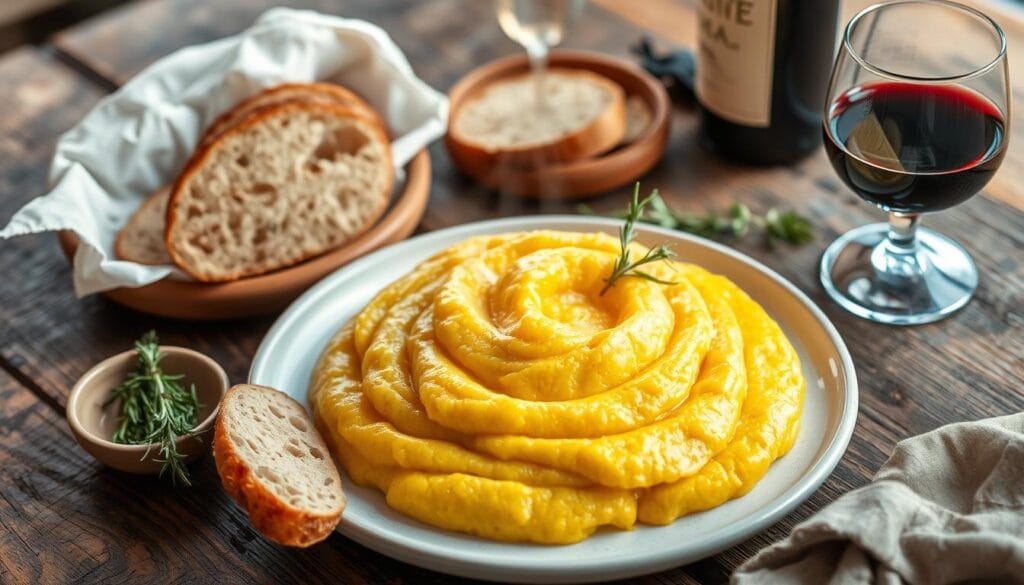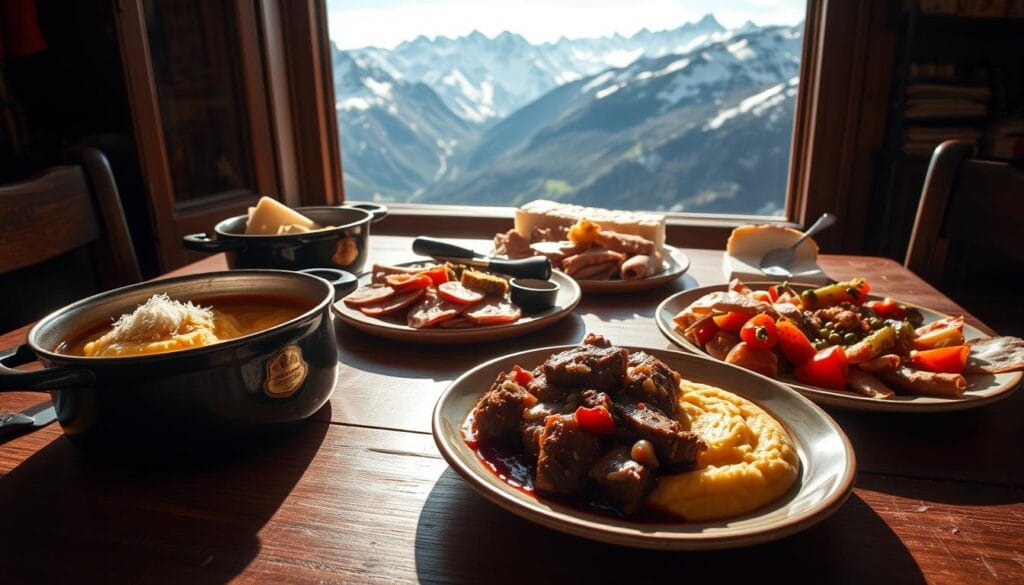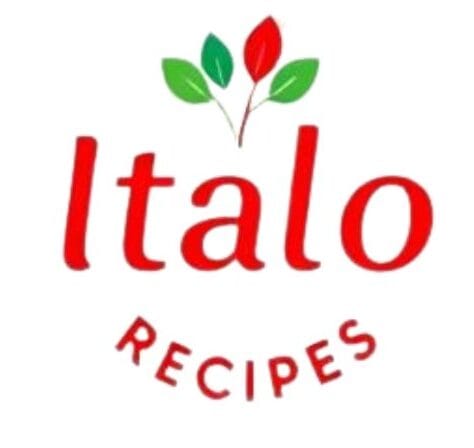Traditional Dishes to Taste in Valle d’Aosta 2025: for an Authentic Food Experience
Planning your 2025 trip to Valle d’Aosta? Get ready to indulge in the region’s rich culinary heritage. The local cuisine is rooted in peasant traditions. It uses simple, genuine ingredients from nature.
The cuisine of Valle d’Aosta truly reflects its geography and cultural influences. You’ll find a variety of local specialties. These include Fontina DOP, Mocetta, and Lardo d’Arnad, showcasing the region’s unique flavors and products.
Table of Contents
Key Takeaways
- Experience the authentic flavors of Valle d’Aosta’s local cuisine.
- Discover the region’s unique products, such as Fontina DOP and Lardo d’Arnad.
- Enjoy the simple, genuine ingredients used in local cooking.
- Explore the cultural heritage and geography that influences the cuisine.
- Savor the traditional specialties that make Valle d’Aosta a culinary gem.
Valle d’Aosta’s Culinary Heritage: A Blend of Italian, French and Alpine Influences
The food of Valle d’Aosta comes from its history and location. It mixes Italian, French, and Alpine tastes. Exploring its dishes, you’ll see a deep culinary heritage shaped by the Alps.
The Unique Geography and Its Impact on Local Cuisine
The mountains and cold of Valle d’Aosta shaped its food. Hearty dishes were needed because of the harsh climate. Meat, cheese, and bread are key to its cuisine.
| Ingredient | Typical Use | Regional Significance |
|---|---|---|
| Fontina Cheese | Used in soups, stews, and as a melted cheese | A staple in Valle d’Aosta cuisine, often considered the region’s crown jewel |
| Beef | Used in stews and carbonada | Reflects the region’s cattle farming traditions |
| Bread | Used in bread soups like Seupa à la Vapelenentse | Essential for survival during harsh winters |
Historical Influences on Valle d’Aosta’s Food Traditions
Valle d’Aosta’s food is shaped by its history and location. Being between Italy and France, it has a unique mix of flavors. You can taste this mix in its dishes, blending Italian and French cooking styles.
Exploring Valle d’Aosta’s food, you’ll find a mix of tastes and stories. Its dishes show the region’s rich history and the strength of its people.
Traditional Dishes to Taste in Valle d’Aosta During Your 2025 Visit
When you visit Valle d’Aosta in 2025, make sure to try the traditional dishes. These dishes reflect the region’s unique culture, shaped by its geography and history. The cuisine is known for hearty meals made with local ingredients, especially Fontina cheese.
Fontina Cheese and Its Cultural Significance
Fontina cheese is a key part of Valle d’Aosta’s food. It’s used in many dishes, like fondue and sauces. Its rich flavor and versatility make it special. The cheese’s DOP status shows its cultural importance.
Carbonada: The Hearty Beef Stew
Carbonada is a traditional beef stew loved in the region. It’s made with beef, red wine, and mountain herbs. Served with polenta or potatoes, it’s a filling meal for mountain explorers.
« La Carbonada valdostana è un piatto unico, completo e sostanzioso, che rappresenta la cucina valdostana nella sua essenza più autentica. »
Seupa à la Vapelenentse: The Iconic Bread Soup
Seupa à la Vapelenentse, or bread soup, is a famous dish from Valpelline. It’s a comforting soup made with bread, vegetables, and local cheeses. It shows the region’s skill in making nourishing meals from simple ingredients.
| Dish | Main Ingredients | Description |
|---|---|---|
| Fontina Cheese | Milk | A staple cheese in Valle d’Aosta, used in various dishes. |
| Carbonada | Beef, Red Wine, Herbs | A hearty beef stew, often served with polenta or potatoes. |
| Seupa à la Vapelenentse | Bread, Vegetables, Cheese | A comforting bread soup, showcasing local ingredients. |
Hearty Mountain Soups and Stews
Valle d’Aosta’s harsh winters led to the creation of comforting soups and stews. These dishes are nourishing and show the local people’s resourcefulness. They use available ingredients to make satisfying meals.
Zuppa di Valpelline: A Comforting Winter Staple
Zuppa di Valpelline, or Seupa à la vapelenentse, comes from the Valpelline valley. It’s a bread soup with Fontina DOP and meat broth. This soup warms the soul and is made with stale rye bread, showing the region’s waste-reducing spirit.
Seupetta: The Traditional Cabbage Soup
Seupetta is a traditional soup that’s simple yet hearty. It’s made with cabbage and other local ingredients. This soup is a staple in the colder months, offering warmth and comfort.
Minestra di Castagne: Chestnut Soup
Minestra di Castagne, or chestnut soup, uses the region’s natural resources. Chestnuts are common in Valle d’Aosta. This soup is creamy and highlights the versatility of chestnuts.
| Soup/Strew | Main Ingredients | Description |
|---|---|---|
| Zuppa di Valpelline | Rye bread, Fontina DOP, meat broth | A traditional bread soup from Valpelline valley |
| Seupetta | Cabbage, local ingredients | A hearty cabbage soup |
| Minestra di Castagne | Chestnuts | A creamy chestnut soup |
These soups and stews are more than meals; they’re a part of Valle d’Aosta’s culinary traditions. They show the region’s ability to make nourishing, flavorful dishes from local ingredients. Exploring the region’s cuisine, you’ll see these hearty soups and stews are key to the experience.
Cheese Specialties of the Region
Valle d’Aosta’s cheese traditions are rich and diverse. The region’s mountain pastures and caves add to the cheeses’ unique flavors. This makes the cheese offerings truly special.
Fontina DOP: The Crown Jewel of Valle d’Aosta Cheeses
Fontina DOP is a key cheese in Valle d’Aosta. It’s used in dishes like Fonduta and gratins. Its quality is ensured by strict production rules.
Fromadzo: The Traditional Farmer’s Cheese
Fromadzo is a significant cheese in Valle d’Aosta. It’s made from cow’s milk and has a rich flavor. The flavor changes with the aging process.
Toma di Gressoney and Other Local Varieties
Toma di Gressoney is a local cheese that shows the region’s cheese-making skills. Other cheeses in Valle d’Aosta also have unique flavors and making methods.
Cheese Aging Processes in Mountain Caves
The aging in mountain caves is key to Valle d’Aosta’s cheese flavors. These caves create the perfect environment for aging. This results in cheeses with rich and complex tastes.
| Cheese Type | Milk Source | Aging Process |
|---|---|---|
| Fontina DOP | Cow | Aged in mountain caves |
| Fromadzo | Cow | Varied aging processes |
| Toma di Gressoney | Cow | Aged in controlled environments |
Exploring Valle d’Aosta’s cheese specialties reveals a unique taste of the region. The mix of traditional methods and geography makes it a cheese lover’s paradise.
« The richness of Valle d’Aosta’s cheese traditions is a reflection of its cultural heritage and the unique terroir that characterizes this Alpine region. »
Meat Dishes That Define Valle d’Aosta’s Cuisine
In Valle d’Aosta, you’ll find many meat dishes that are both hearty and tasty. The area’s cooking traditions focus on meat, using local ingredients and old methods.
Carbonade Valdostana: Beef Marinated in Wine
Carbonade Valdostana is a famous dish. It has tender beef marinated in red wine and cooked with mountain herbs. This slow-cooked stew is a true taste of Valdostan cuisine.
Mocetta: The Traditional Cured Meat
Mocetta is a loved specialty, a cured meat dried in the air. It’s often served thin and shows the region’s curing skills. It’s great as an antipasto or in many local dishes.
Boudin: Blood Sausage with Mountain Herbs
Boudin, or blood sausage, is a tasty treat. It’s made with a mix of mountain herbs. This sausage is a highlight of the region’s cooking, made from local ingredients.
Lard d’Arnad DOP: The Protected Cured Pork Fat
Lard d’Arnad DOP is a special cured pork fat. It’s known for its unique flavor. This delicacy is used to make many local dishes even tastier.
These meat dishes show off the region’s cooking skills. They also show its dedication to keeping traditional cooking alive and using local ingredients.
Polenta Variations and Accompaniments

Polenta is a key part of Valle d’Aosta’s food scene. It brings different tastes and textures that match the area’s rich food history. You can try many polenta dishes when you visit Valle d’Aosta in 2025.
Polenta Concia: Enriched with Local Cheese
Polenta Concia is a favorite, made with local cheese, butter, and sometimes cured meats. It’s a big part of Valdostan food and goes well with other local dishes. This makes meals even better.
Traditional Serving Methods and Pairings
In Valle d’Aosta, polenta goes with many foods, like meat stews and roasted game. The carbonada, a rich beef stew, pairs well with polenta’s earthy taste.
The Cultural Significance of Polenta in Mountain Communities
Polenta has been important in the region for centuries. It gives mountain communities strength and comfort. Its role is clear at local festivals and family meals.
Exploring Valle d’Aosta’s traditional foods, you’ll see polenta’s role. It’s a key ingredient that fits many flavors and cooking styles. This makes it a big part of the area’s food identity.
Sweet Treats and Desserts from the Alpine Region
Exploring Valle d’Aosta’s culinary scene reveals a variety of sweet treats. These desserts reflect the region’s Alpine heritage. They blend traditional ingredients with local flavors, showcasing the area’s cultural and geographical uniqueness.
Tegole: The Thin Almond Cookies
Tegole are a specialty in the Aosta Valley. They are known for their thin, crisp texture and almond flavor. These cookies are great as a sweet treat or dessert, especially with coffee or tea.
The traditional recipe uses simple ingredients. It highlights the quality of local almonds.
Martin Sec Pears in Wine
Martin Sec pears poached in wine is another dessert that highlights Valle d’Aosta’s fruit and wine traditions. This dessert combines the region’s produce with its wine culture. It creates a perfect balance of flavors.
The pears are carefully selected and cooked in local wine. This makes for a delicious and authentic dessert experience.
Blanc Manger: The Ancient Dessert
Blanc Manger is an ancient dessert that has been part of Valle d’Aosta’s culinary heritage for centuries. It reflects the region’s rich history and cultural influences. This dessert is a unique blend of local ingredients and historical recipes.
| Dessert | Description | Key Ingredients |
|---|---|---|
| Tegole | Thin almond cookies | Almonds, sugar, egg whites |
| Martin Sec Pears | Pears poached in wine | Martin Sec pears, local wine, sugar |
| Blanc Manger | Ancient dessert | Milk, cream, sugar, almonds |
Where to Experience Authentic Valle d’Aosta Cuisine in 2025

For a real taste of Valle d’Aosta in 2025, check out local eateries and food events. These places show off the region’s spécialités culinaires de la vallée d’aoste. You’ll find traditional dishes made with local ingredients in various settings.
Traditional Restaurants and Mountain Refuges
Traditional restaurants and mountain refuges are great for authentic Valle d’Aosta food. They offer local specialties in a rustic atmosphere. Try dishes like Carbonada and Seupa à la Vapelenentse, which are must-tries.
Food Festivals and Events Throughout the Year
Valle d’Aosta celebrates its food all year with festivals and events. These are perfect for trying local foods and drinks. Join these festivals to dive into the region’s food culture.
| Event | Month | Location |
|---|---|---|
| Food Festival | June | Aosta |
| Wine Tasting | September | Gressoney |
| Cheese Festival | July | Cogne |
Agriturismo Experiences: Farm-to-Table Dining
Agriturismos in Valle d’Aosta offer farm-to-table dining. They use fresh, local ingredients for authentic flavors. You can also learn about local farming and making products like Fontina cheese.
Cooking Classes and Food Tours in Valle d’Aosta
Take cooking classes or food tours to learn more about Valle d’Aosta’s cuisine. These activities teach you about local ingredients and cooking methods. You’ll get to make spécialités culinaires de la vallée d’aoste with local chefs.
Wine and Beverages to Pair with Traditional Valle d’Aosta Dishes
To enjoy Valle d’Aosta’s traditional dishes, try the local wines and drinks. The region’s special terroir and making methods create unique flavors. These enhance your meal.
Local Wine Varieties: Petit Rouge, Fumin, and Prié Blanc
Valle d’Aosta has its own wines, each with special traits. Petit Rouge is light and crisp, great with cheeses and meats. Fumin is a strong red, perfect for meaty dishes like carbonada. Prié Blanc is a crisp white, ideal for salads and fish.
| Wine Variety | Characteristics | Pairing Suggestions |
|---|---|---|
| Petit Rouge | Light color, crisp taste | Local cheeses, cured meats |
| Fumin | Robust, full-bodied | Carbonada, hearty meat dishes |
| Prié Blanc | Crisp, refreshing | Salads, fish dishes |
Génépy: The Alpine Herbal Liqueur
Génépy, a local herbal liqueur, is enjoyed as a digestif. It’s made from alpine herbs and aids digestion. It also adds a unique flavor to the region’s dishes.
Valle d’Aosta’s Craft Beer Scene
The region is growing its craft beer scene. These beers, made with local ingredients, offer a modern take on Valle d’Aosta’s drinks.
Seasonal Specialties: When to Visit for the Best Culinary Experiences
Valle d’Aosta offers a culinary journey that changes with the seasons. You can enjoy warm winter dishes or fresh summer produce. Knowing the seasonal specialties will make your visit even better.
Winter Comfort Foods and Holiday Traditions
Winter in Valle d’Aosta brings hearty comfort foods. Try Carbonada, a rich beef stew, and Seupa à la Vapelenentse, a bread soup. The region’s holiday traditions also include special dishes like Tegole, thin almond cookies, and Martin Sec pears in wine.
Summer Alpine Herbs and Fresh Produce
Summer brings fresh Alpine herbs and produce to Valle d’Aosta’s cuisine. Enjoy dishes with wild mushrooms and herbs. The summer is also great for farm-to-table dining at agriturismos.
Autumn Harvest Celebrations and Dishes
Autumn in Valle d’Aosta celebrates the harvest with special dishes. Try Minestra di Castagne, a chestnut soup, and other autumn specialties. It’s also a good time to visit food festivals and events.
Dining Etiquette and Customs in Valle d’Aosta
Respecting local customs is key when dining in Valle d’Aosta. Mealtimes are sacred, so enjoy them slowly. Learning about the local dining culture will make your experience richer and more enjoyable.
Conclusion: Embracing the Authentic Flavors of Valle d’Aosta in 2025
As you finish your food journey in Valle d’Aosta, you’ve found the area’s real tastes. You’ve tried dishes like Fontina cheese and Carbonada valdostana. Each one shares a piece of the region’s history and culture.
Valle d’Aosta’s food shows off its rich culture and mountain setting. It offers a special food experience. You can keep exploring in 2025, diving into local food traditions and enjoying the dishes that make Valle d’Aosta special.
If you love food or want to try Italy’s real tastes, Valle d’Aosta is the place. It promises unforgettable food memories. So, come back and try the traditional dishes in Valle d’Aosta. Let the region’s food heritage impress your taste buds.

